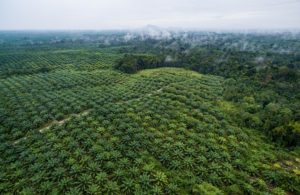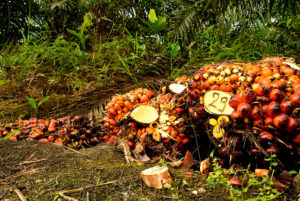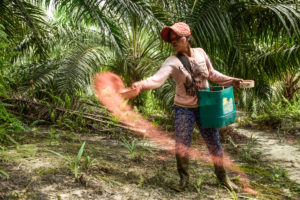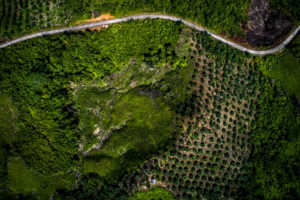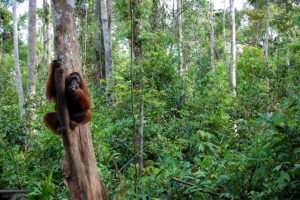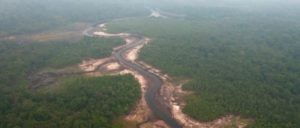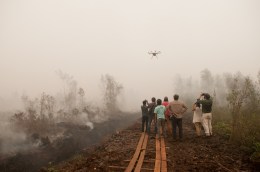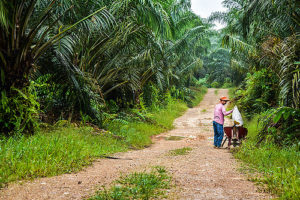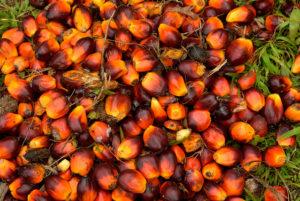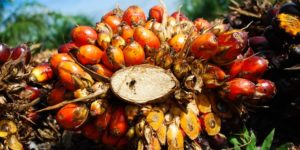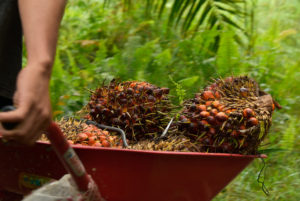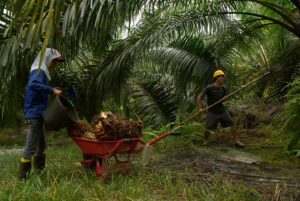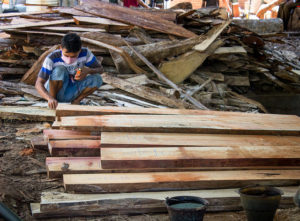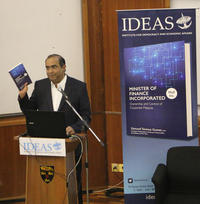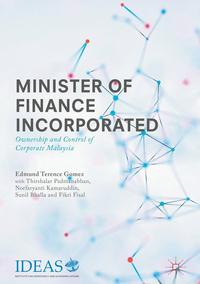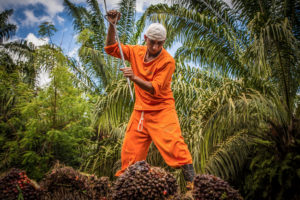
In an ideal world, palm oil production would cause no deforestation, and have a transparent and fair supply chain. In reality, the impacts of the sector have been the cause of ethical concerns worldwide.
Palm oil is Indonesia’s most important commodity. In 2017 the country produced 37.8 million tonnes of crude palm oil (CPO) and exported over 80 percent of it, with a value of $31.8 billion. Indonesia is the world’s biggest palm oil producer, and its biggest exporter too.
The strong market demand of palm oil has led to a vast expansion of plantations. Currently smallholders make up around 40 percent of the production market, and around one-third of these do not have the correct land tenure permits. In some cases, the smallholders have moved into state-owned forest areas and in many cases, this occupancy creates conflict.
In 2017, the Ministry of Agriculture’s Directorate General of Plantations found that of the 2.5 million hectares of oil palm plantations on state-owned forests, 70 percent of these were controlled by smallholders.
To get to the bottom of why oil palm plantations continue to encroach into state forest areas, Center for International Forestry Research (CIFOR) organized a workshop in collaboration with Center for Research and Development on Social, Economics, Policy and Climate Change (P3SEPKI): ‘Linking science to policy: the role of research in the effort to accelerate solution of tenurial problems in oil palm plantation in forest areas.’
Solving conflicts by understanding the underlying cause
In his presentation, Ismatul Hakim, senior researcher at P3SEPKI, says that complex tenure conflicts can’t be resolved without understanding why oil palm plantations are encroaching into state forest areas. He believes assessing how different types of farmers take control of lands, what strategies they use, and most importantly, the motivations of the farmers, is needed before long-lasting resolution is achieved.
According to Hakim’s research, this can be segregated into four categories:
The first is maladministration, where a lack of coordination leads to disputes as it is unclear who legally manages the forest areas – is it the Ministry of Environment and Forestry or the local government?
Second, incomplete forest area gazettements- a legal declaration that announces state ownership- coupled with a lack of clarity and communication on where the gazetted boundaries lay, have caused local people, in need for income, to expand their plantations into unmarked forest areas.
Third, inequality of power and land ownership has caused people to encroach. Local people have watched big investors and corporations take control of and transform their ancestral land, and store land for the future (known as ‘landbanking’).
And finally, the ineffective implementation of policies for forest area release and land swap- where the government gives areas of new land to plantations in exchange for restoring degraded land. To add, he says, this is further hampered by the slow pace of conflict resolution.
Drawing from his research, Bayu Eka Yulian from Bogor Agricultural University (IPB) added “Oil palm plantations have expanded rapidly in East Kalimantan, particularly those smallholders in a silence mode.” He argued while corporations might generally adhere to tighter regulations, small holder farmers, including those with access to more capital and information, appear to expand their plantations at a scale from 0.5 to 3 hectares of land or even more, without restraint.
The attendees agreed that the situation will keep perpetuating itself without intervention. Rapid expansion is causing damaging changes to the landscape, but farmers are also becoming trapped- as they become highly dependent on a monoculture crop, and get trapped on a single source of income.
Read also: The long and winding road to sustainable palm oil

Solving tenure issues through better governance
In September 2018, the Indonesian government issued a three-year moratorium on new oil palm plantation permits and devised attempts to increase productivity, expressed in Presidential Instruction (Inpres) No. 8/2018. Along with other prevailing policies, this moratorium offers an excellent opportunity to resolve tenure issues.
However, it was feared that the temporary halt might simply not be enough.
“It was generally agreed by the workshop participants that regulations should be clear and not create legal uncertainties,” said CIFOR scientist Heru Komarudin, adding that plantations that are currently operating on state forests should be given enough time to either relocate or have their land status legally changed to non-forest areas.
He similarly believes that smallholder plantations already illegally on state forests should be given the chance to confirm their land status through agrarian reform or social forestry schemes that are already in place.
“Priority should be given to those committed to practising ethical agriculture – by preventing further deforestation and promoting fair trade working rights,” said Komarudin. To create policies that work, the “heterogeneous typology” of smallholders, and the impact of plantations on local people need to be taken into account, he adds.
Furthermore, there is opportunity to raise state funds by getting tenure issues right. Legislating and governing the use and rental of state forest can then be further propped up by compensation payments by companies who have illegally encroached. While strict law enforcement could be used to police the tenure issues, granting land amnesty to those that depend heavily on these lands may be a breakthrough.
Internationally, the European Union Renewable Energy Directive which plans to phase out the use of palm oil for biofuel by 2030, has put pressure on the Indonesian palm producers. In responding to this development, workshop attendees agreed that foreign diplomacy should be strengthened by consolidating the national position, which in turn would make the Indonesian Sustainable Palm Oil (ISPO) certification credible.
“Building solidarity with other producing countries to promote best practices and a sustainable and legal palm oil industry is essential,” says Maharani Hapsari, PhD and lecturer of international relations at Gadjah Mada University. “Indonesia should focus its diplomacy on palm oil global trade not only to strengthen authority, but also to enhance legitimacy of forest and oil palm governance by the broadest possible range of stakeholders.”
By Nabiha Shahab and Dominique Lyons, originally published at CIFOR’s Forests News.
For more information on this topic, please contact Heru Komarudin at h.komarudin@cgiar.org.
This research forms part of the CGIAR Research Program on Forests, Trees and Agroforestry (FTA), which is supported by the CGIAR Trust Fund.
This research is part of the Governing Oil Palm Landscapes for Sustainability (GOLS) project, which is supported by the United States Agency for International Development (USAID). The GOLS project supports effective and equitable implementation of the New York Declaration on Forests commitments by helping to align public and private policies and actions, and by delivering targeted, research-based evidence to key stakeholders and practitioners.












